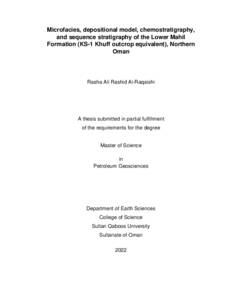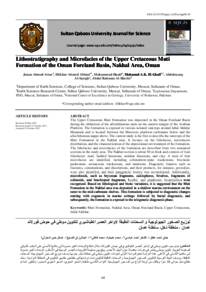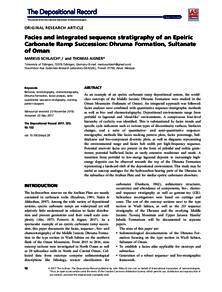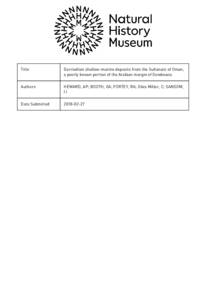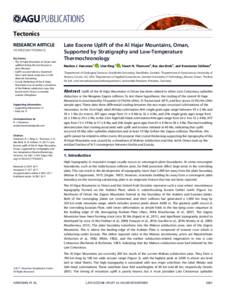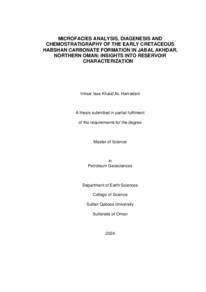Document
Microfacies, depositional model, chemostratigraphy, and sequence stratigraphy of the lower Mahil formation (KS-1 Khuff outcrop equivalent), Northern Oman.
Other titles
السحنات الدقيقة، نموذج البيئة الترسيبية، الطبقات الكيميائية، وتسلسل الطبقات لتكوين محيل (المكافئ السطحي لخف الطبقة 1-) في شمال عمان
Publisher
Sultan Qaboos University.
Gregorian
2022
Language
English
English abstract
This study presents a detailed microfacies analysis, a δ
13C and δ 18O values from whole-rock samples, and spectral gamma-ray records of the Lower Triassic
(Induan) Mahil Formation (Khuff outcrop equivalent (KS-1)) in Jabal Akhdar, at
the Saiq Plateau section and Wadi Sahtan section, in Northern Oman. The two
sections were measured and sedimentologically logged along a depositional dip
direction emphasizing color, lithology, grain component, bed thickness, nature of
bed contact, lateral continuity of bed, and fossil content. One hundred seventy nine fresh rock samples were collected from various lithofacies every 0.5 m.
Moreover, high-resolution spectral gamma-ray measurements were taken at
every 10 cm from both logged sections. The collected samples were polished and
powdered for carbon and oxygen isotope chemostratigraphy analysis.
Furthermore, the collected samples were thin sectioned after blue epoxy
impregnated, and then they were half stained with Alizarin Red S and Potassium
Ferricyanide for mineralogical identification. The point-counting model
compositions were carried out by counting 300 points for each thin section to
reconstruct the origin components, obtain precise quantification, develop
reflectable microfacies, and construct the depositional model for the Lower Mahil
Formation. Moreover, the high-resolution carbon isotope data integrated with the
high-resolution spectral gamma-ray data to build a robust stratigraphic framework
for the Lower Mahil KS-1 Formation.
Consequently, twenty-four microfacies were identified; four are only
recognized in the Wadi Sahtan logged section, twelve are restricted to the Saiq
Plateau logged section, and eight are common for both sections. The Mahil
Formation consists of backshoal to foreshoal carbonate facies, with shoal facies
restricted to the Saiq Plateau logged section. The backshoal facies was
characterized by abundant non-skeletal grains with breccia. The shoals were
predominantly oolitic intraclasts and foraminiferal packstone-grainstone.
Foreshoal carbonate facies, on the other hand, has mixed skeletal and non skeletal grains with weakly developed hummocky cross-stratified beds.
Moreover, five fourth-order depositional sequences were identified based on
stable carbon isotopes, uranium, and total gamma-ray profiles. Four of them are
complete, showing transgression and regression phases, and one is incomplete
comprise only a transgressive phase. The δ 13C curve of the Lower Mahil KS-1 Formation can be correlated with the others around the Tethys, indicating that the Lower Mahil KS-1 Formation represents the near-primary signal of C isotope
variations of the coeval seawater thus could be considered as a reference section
for further studies.
Member of
Resource URL
Arabic abstract
تقدم هذه الدراسة تحليلا تفصيليا عن السحنات الدقيقة، والبيئة الترسيبية، وقراءات نظائرالكربون والأكسجين الثابتة بالأضافة الى سجلات أشعة غاما الطيفية لنتوء محيل السفلي من العصر الأسفل ترياسي )إندوان(، المكافئ ل تكوين خف في باطن الأرض )الطبقة1-( من خالل دراسة الصخور في كل من هضبة سيق ووادي السحتن في شمال عمان. تم إعداد السج الت الرسوبية ل النتوئين مع التركيز على اللون ، والليثولوجيا ، ومكون الحبوب ، وسمك الطبقة ، وطبيعة الحدود، والأستمرارية الجانبية لألسرة ، والمحتوى الأحفوري. مائة وتسعة وسبعون عينة من الصخور جمعت كل نص متر من كال النتوئين. عالوة على ذلك ، تم أخذ قياسات ألشعة غاما الطيفية عالية الدقة كل عشرة سم. بعد ذلك تم صقل العينات التي تم جمعها وأخذ المسحوق منها للتحليل الكيميائي لنظائرالكربون والأكسجين. بالأضافة على ما سبق ، تم إعداد شرائح رقيقة من العينات التي تم جمعها بعد تشريبها بالأيبوكسي الأزرق، ثم غمست أنصاف جميع الشرائح في محلول )الأرزرين الأحمر)س( و بوتاسيوم الفيريسياند( لتحديد الهوية المعدنية. تم تنفيذ نموذج عد النقاط عن طريق عد ثالثمئة نقطة لكل شريحة في محا ولة ل التنبوء بمكونات الأصل ، والحصول على تقدير دقيق لتطور الأحياء الدقيقة ، وبالتالي بناء نموذج ترسيبي مؤكد لتكوين محيل السفلي. عالوة على ذلك ، تم التكامل بين بيانات نظائر الكربون عالية الدقة مع بيانات أشعة غاما الطيفية عالية الدقة لبناء إطار طبقي لتكوين محيل السفلي. ونتيجة لذلك ، تم تحديد أربعة وعشرين نوعا من السحنات الدقيقة ؛ أربعة أنواع من السحنات موجودة فقط في نتوء وادي السحتن ، أما هضبة سيق فانفردت باثنتي عشر ة سحنة دقيقة، بينما اشترك كال القسمين في ثمانية أنواع من السحنات الدقيقة. يتكون تكوين محيل من سحنا ت كربونات المنحدرات الخلفية إلى المنحدرات الأمامية ، والقليل من سحنات المياه الضحلة التي لوحظ تطورها على نتوء هضبة سيق فقط. تتميز السحنات في المنحدرات الخلفية بوجود حبيبات غير هيكلية وفيرة مع البريشيا. أما المياه الضحلة في الغالب تتكون من الأوليتيك/حبيبات متداخلة من الصخور الحبيبية. من ناحية أخرى ، تحتوي سحنات المنحدرات الأمامية على حبيبات هيكلية وغير هيكلية مختلطة مع سمات رسوبية متقاطعة ضعيفة التطور)الهموكي(. عالوة على ما سبق ، تم تحديد خمسة طبقات ترسيبية من الدرجة الرابعة بنا ًء على نظائر الكربون المستقرة واليورانيوم و أشعة غاما الكلية. أربعة طبقات كاملة ، فهي تظهر مراحل تجاوز وانحدار ، وواحدة غير مكتملة تشكل فقط مرحلة تجاوز. يمكن ربط منحى الكربون ل تكوين محيل )أسفل الترياسي( مع منحيات كربونية أخرى حول منطقة التيثيس، ويشير هذا التوافق على إمكانية إعتبار تكوين محيل أسفل الترياسي كنموذج للبحوث المستقبلية لدراسة تسلسل الطبقات المتكونة في نفس الفترة الزمنية في المنطقة.
Category
Theses and Dissertations

